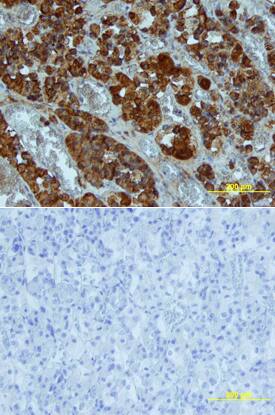Human Growth Hormone Biotinylated Antibody
R&D Systems, part of Bio-Techne | Catalog # BAF1067


Key Product Details
Species Reactivity
Validated:
Cited:
Applications
Validated:
Cited:
Label
Antibody Source
Product Specifications
Immunogen
Phe27-Phe217
Accession # CAA23779
Specificity
Clonality
Host
Isotype
Scientific Data Images for Human Growth Hormone Biotinylated Antibody
Growth Hormone in Human Pituitary.
Growth Hormone was detected in immersion fixed paraffin-embedded sections of human pituitary using Goat Anti-Human Growth Hormone Biotinylated Antigen Affinity-purified Polyclonal Antibody (Catalog # BAF1067) at 10 µg/mL overnight at 4 °C. Tissue was stained using the Anti-Goat HRP-DAB Cell & Tissue Staining Kit (brown; Catalog # CTS008) and counterstained with hematoxylin (blue). Lower panel shows a lack of labeling if primary antibodies are omitted and tissue is stained only with secondary antibody followed by incubation with detection reagents. View our protocol for Chromogenic IHC Staining of Paraffin-embedded Tissue Sections.Applications for Human Growth Hormone Biotinylated Antibody
Immunohistochemistry
Sample: Immersion fixed paraffin-embedded sections of human pituitary
Western Blot
Sample: Recombinant Human Growth Hormone (Catalog # 1067-GH)
Formulation, Preparation, and Storage
Purification
Reconstitution
Formulation
Shipping
Stability & Storage
- 12 months from date of receipt, -20 to -70 °C as supplied.
- 1 month, 2 to 8 °C under sterile conditions after reconstitution.
- 6 months, -20 to -70 °C under sterile conditions after reconstitution.
Background: Growth Hormone
Growth Hormone (GH), also known as somatotropin, is a member of a family of growth factors that includes prolactin, placental lactogens, proliferins, and somatolactin (1, 2). It is synthesized primarily by somatotropes in the anterior pituitary and is stored in secretary granules. The pulsatile release of GH into circulation is regulated by the concerted actions of the hypothalamic hormones - GH-releasing hormone (GHRH) and somatostatin (SST) - as well as by signals from the periphery - ghrelin (3) and leptin (4). The human GH cDNA encodes a 217 amino acid (aa) residue precursor protein with a 26 aa putative signal peptide. By alternative splicing, at least four isoforms of GH have been identified (5).
Human GH is a pleiotropic cytokine that exerts its biological actions by binding to the transmembrane GH receptor, which is present in many cell types (1, 2). GH stimulates the liver and other tissues to produce IGF-I, which regulates growth and metabolism. GH has also been shown to have direct effects on growth that is independent of IGF-I. GH, directly or indirectly via IGF-I, can act on B cells, T cells, NK cells, macrophages, and neutrophils to exert immunomodulatory activities (6). In addition, GH can act directly on various cell types to induce lipolysis, lactation, amino acid uptake, and protein synthesis (1, 2, 6).
References
- Goffin, V. et al. (1996) Endocrine Rev. 17:385.
- Le Roith, D. et al. (2001) Endocrine Rev., 22:53.
- Kojima, K. et al. (1999) Nature, 402:656.
- Tannenbaum, G. et al. (1998) Endocrinol. 139:3871.
- Welniak, L.A. et al. (2002) J. Leukoc. Biol. 71:381.
Alternate Names
Entrez Gene IDs
Gene Symbol
UniProt
Additional Growth Hormone Products
Product Documents for Human Growth Hormone Biotinylated Antibody
Product Specific Notices for Human Growth Hormone Biotinylated Antibody
For research use only